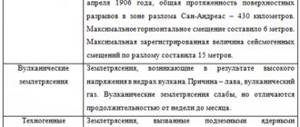Social studies lesson summary “Political parties and movements”
Teacher's story:The need to protect the interests of various social groups gives rise to associations that express the interests of these groups and participate in political life.
Let's write it down in a notebook: Socio-political movements
are mass, voluntary formations created on the initiative of people from below.
Now read an excerpt from the “Federal Law “On Public Associations” and answer the questions:
- What goals do social movements pursue?
- What is the highest governing body of a social movement?
Remember from the course of modern history what public associations appeared in the world in the 50-70s. XX century, what goals did they pursue?
What do they have in common?
To achieve their goals, such socio-political movements strive to influence the government in one way or another. They organize citizens' appeals to various government bodies, come up with civil initiatives on issues of political life, hold rallies, demonstrations, picketing, and use other forms of political activity.
It is the desire to resolve some socially significant issues through power structures that gives such movements a political character. Some of these movements, having solved their limited problems or discovered their inconsistency, cease to exist. Others are gradually transforming into political
parties.
Let's write it down in a notebook: A political party is an organization that unites the most active part of certain social groups or the population as a whole, expressing and defending relevant social interests.
Read page 61 in the textbook and tell me how political parties differ from other associations.
Now let’s write down in a notebook the functions that political parties perform:
- Political –
mastery of state power in order to implement its program;
- Social representation –
each party expresses the interests of some social layer, or tries to create a strong support for itself in society;
- Social integration (unification) –
reconciling the interests of various social groups, achieving harmony in society;
- Political Recruitment –
training and promotion of personnel for various political institutions;
- Electoral –
organization and participation in election campaigns.
There are a huge number of different political parties in the world. They are classified on various grounds. Most of the classifications are known to you from the history course.
Depending on their program settings, left, center and right parties are distinguished; in relation to the policies being pursued: ruling and opposition; by organizational structure: personnel (only those members who vote for a given party in elections carry out activities only during the election period) and mass; on ideological grounds: liberal, conservative, social democratic, communist, fascist, nationalist, clerical, etc.
In different countries of the world there are different numbers of parties, which means different party systems.
We write in a notebook: The party system is a set of parties (ruling and opposition) taking part in the struggle for power and its implementation.
- One-party system (USSR, Japan, China)
- Two-party system (USA, UK)
- Multi-party system (Russia, France, Italy).
In our country at the beginning of the twentieth century. There were also several parties. Subsequently, for many years there was only one party left - the Communist Party. Currently, new political parties have emerged that strive to ensure that people vote for their representatives in elections in order to influence the activities of government bodies through them. The multiparty system in Russia has been revived in the last two decades. The process of its formation is not yet completed.
§ 8 (§ 32). Political parties
Questions and assignments.
1. Describe a political party and show its place in society.
A political party is an organized group of people who share a common political program and strive to legally come to power by installing their own president and forming their own government.
It represents a political organization that expresses the interests of social groups and unites their most active representatives.
Party leadership is chosen at party meetings or congresses. All party members make monetary contributions, they support the party apparatus, hold party events, publish party literature, etc. The more massive the party is, the more money there is in the party treasury. Thus, the vital interest for any party is its mass appeal and popularity. Small parties that do not enjoy widespread support eventually disintegrate, merge with larger ones, and transform, hoping to survive in a renewed form.
There is a fierce political struggle between political parties. The strong absorb or displace the weak.
Political parties are organizations that seek control over the government of the country. They are one of the main sources of political influence. Parties act as intermediaries between the individual and the government, while at the same time being mechanisms for promoting their leaders to power.
The main functions of political parties in society include representation of social interests, social integration, political socialization, creation of ideological doctrines, struggle for state power and participation in its implementation, development of a political course, formation of public opinion, etc.
2. * Do not the two characteristics of a political party contradict each other - being an organized group of like-minded people and serving as a representative institution of democracy? Express your point of view.
The main goal of a political party is to seize power through legal means. And a political party consists of like-minded people pursuing the same goals set out in their program. Representative democracy is a political regime in which the people are recognized as the main source of power, but government is delegated to various representative bodies, whose members are elected by citizens. Parties are precisely the institution of representative democracy.
Thus, these two characteristics do not contradict each other.
3. * What stage of development of democracy does the abundance of political parties indicate? Explain your answer.
The abundance of political parties indicates the beginning of the formation of democracy in the state. These parties have many similarities, often they differ only in accents. However, they are in no hurry to unite with each other.
In countries with a long democratic tradition there is no such multi-party system. For example, in the USA and England there are only 2 leading political parties.
4. What is a multi-party system and how does it manifest itself in different countries?
Multi-party system is a party system in which more than two political parties exist and operate legally in the country.
Some countries have only a one-party system (China, Cuba, North African countries), others have a two-party system (USA, England, Canada). Most European countries have a multi-party system (Germany, Italy, Belgium). In authoritarian regimes, one party is in power. The rest are either banned or occupy a semi-legal position (Mexico - more than 12 parties are registered, only one rules).
The Constitution of the Russian Federation recognizes political diversity and multi-party system (Article 13).
5. * Why are there only two leading parties in the USA and England, but the quality of democracy does not suffer from the small number of parties, while in Russia there are many of them, but democratic transformations are taking place with great difficulty?
In those countries where a multi-party system is just beginning to take shape, there are dozens and hundreds of political parties and associations. In countries with a long democratic tradition, there is no multi-party system. In England and the USA there are two leading parties. In Russia, the demarcation lines are just beginning to emerge. Numerous parties have many similarities, often they differ only in accents. Thus, the Union of Right Forces and Yabloko express the interests of democracy and the market with a Western orientation, but do not want to unite with each other. When they go to elections, the intelligentsia, who usually vote for them, do not know who to give preference to. As a result, the electorate is fragmented, with each party separately receiving fewer votes than they would have received together.
6. How can political parties exercise control over a country? Can you illustrate this with an example from our country or foreign countries.
Parties achieve control over the government by delegating more of their representatives to it than their opponents. Parliament is usually the way station. It is here that the party tries to get the largest number of seats. If in a given country the government is formed by the parliamentary majority party, as in England, then the path to the top occurs directly through victory in parliament. If the country has a strong power of the president, who, according to the constitution, must stand above party interests and not support any party, but instead form a government subordinate to him and not to parliament, then control can be achieved indirectly - through the adoption of laws favorable to the government, a negative assessment of its activities in parliament, sabotage of its decisions, criticism in the press, etc.
In authoritarian regimes, one party is in power. The rest are either banned or occupy a semi-legal position. There are more than 12 parties registered in Mexico, but only one party controls the government; The USSR, where all power was concentrated in the hands of one party.
In Great Britain, the government is formed after parliamentary elections. The leader of the party that wins the majority of seats in the House of Commons is appointed prime minister. On his recommendation, the head of state (the Queen of Great Britain) appoints the remaining members of the government. If the House of Commons passes a vote of no confidence in the government, it must resign.
7. What functions does a political party perform? Which one do you think is the most important? And if one function begins to contradict another, does the authority of the political party suffer from this?
Political parties perform the following functions:
1. Political – mastery of state power.
2. Representative – expression of the interests of certain groups and segments of the population.
3. Electoral – organization and participation in election campaigns.
4. Socialization - education of loyal members and the formation of a political culture of citizens.
5. Recruitment – selection and nomination of politically competent leaders for parliament and government.
I can't say that any of these features will be the most important. A political party must perform all these functions, otherwise it will not succeed in gaining power.
If, for example, a political party ceases to perform a representative function, then it will lose authority. That is, she entered the government and parliament, but is not going to fulfill the interests of her supporters. Consequently, she will lose her votes in the next elections.
?Problem. Do you think young people should participate in the work of political parties?
Young people need to participate in the work of political parties. We need young people with new views, new ideas, new solutions to emerging problems. In my opinion, only young people can know about the problems of young people. This is also an opportunity to gain some experience, because someone in the future will need to lead the state.
Workshop. Compare the contents of the two columns of the table describing the functions of a political party. (Table corrected)



